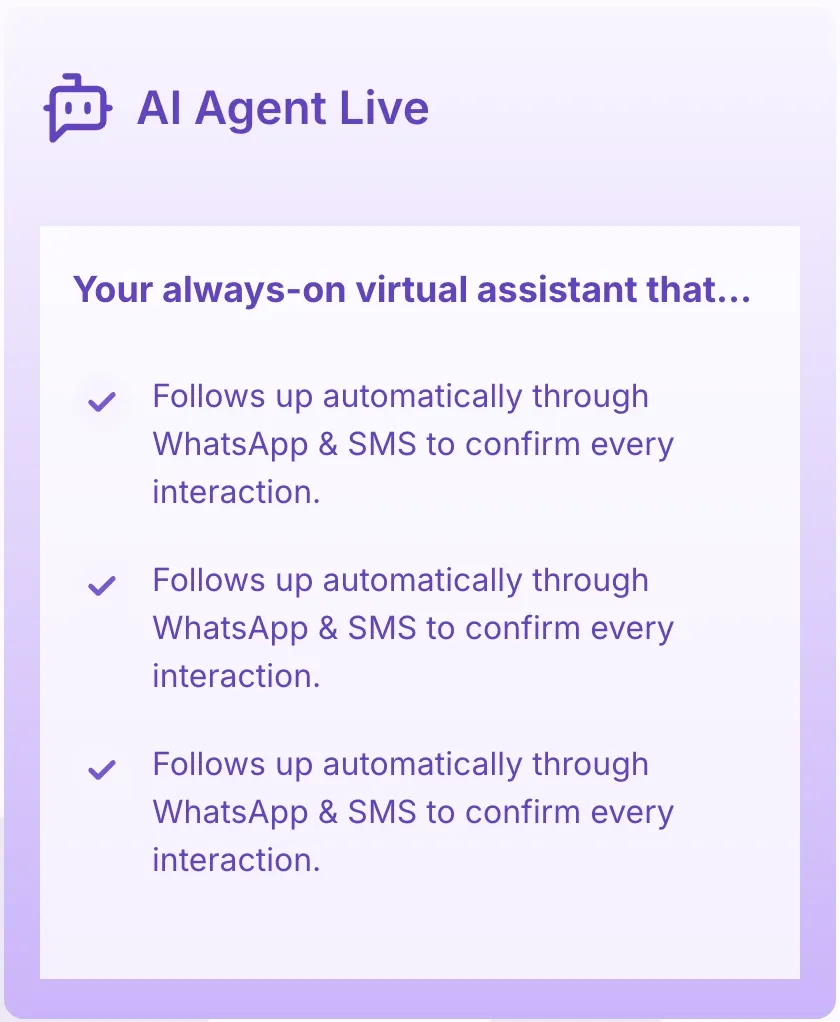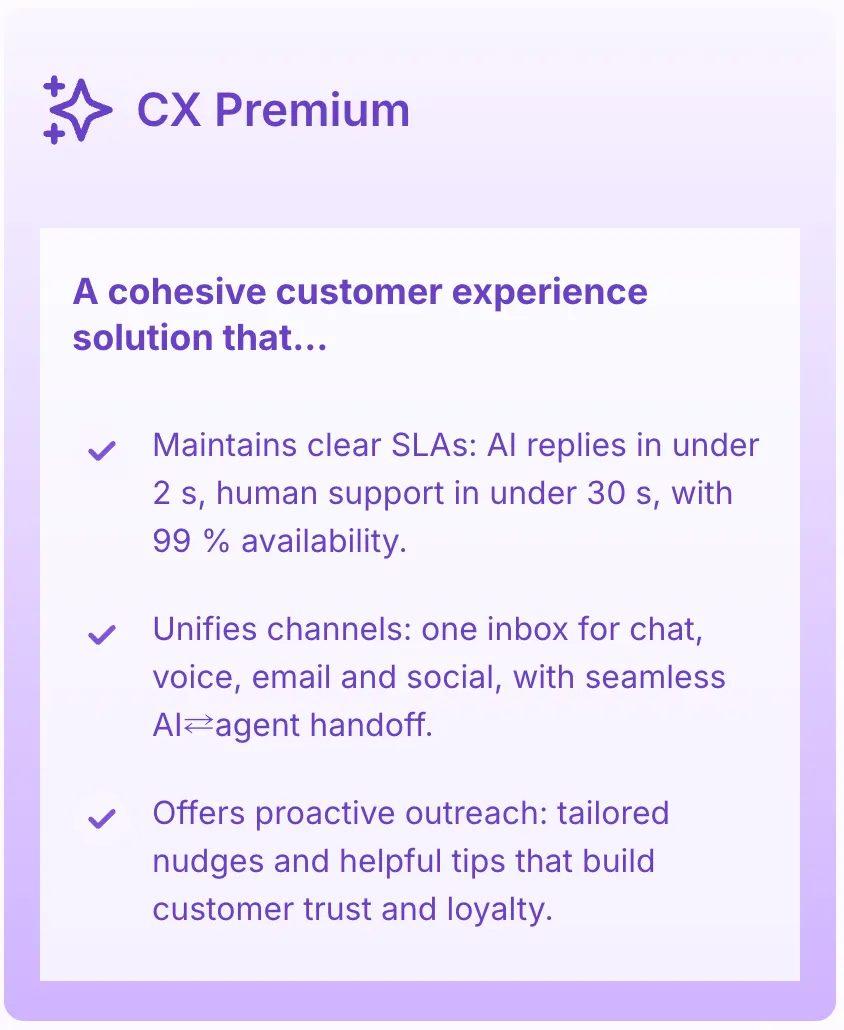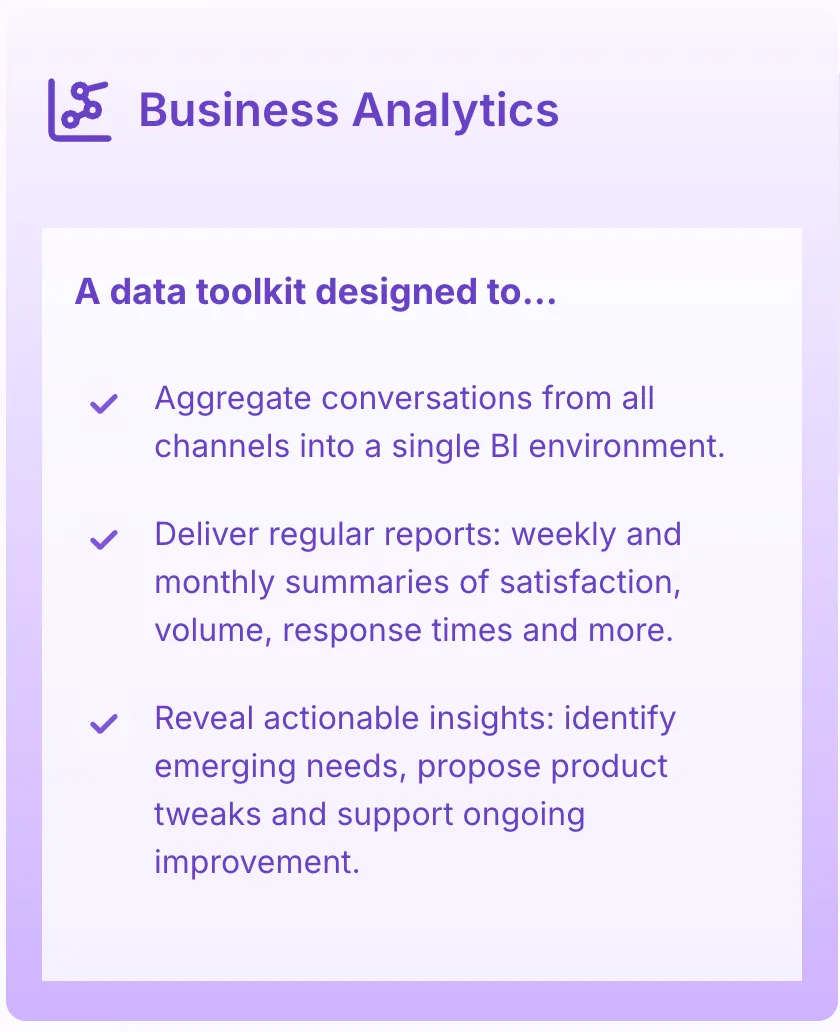The impact of customer success on modern business operations is profound:
- Accelerated Business Growth: Companies with strong customer success programs see increased retention rates and expanded revenue through upsells and cross-sells
- Enhanced Customer Loyalty: Proactive engagement builds trust and creates long-term relationships that turn customers into brand advocates
- Improved Product Adoption: Strategic guidance helps customers realize value faster and utilize products more effectively
2024 brings transformative changes to customer success management. You'll discover how AI-powered platforms are revolutionizing customer interactions, with companies like Hyundai achieving remarkable results through automated engagement systems. The integration of predictive analytics is enabling businesses to anticipate customer needs and prevent churn before it happens.
This guide explores the essential elements of modern customer success, from building effective strategies to implementing innovative tools. You'll learn about the critical roles driving these initiatives, best practices for customer onboarding, and proven methods for gathering actionable feedback that fuels continuous improvement.
Understanding Customer Success in the Modern Business Landscape
Customer success represents a strategic shift in how businesses approach customer relationships. Unlike traditional customer service models, customer success operates as a proactive force throughout the entire customer journey.
Key Elements of Modern Customer Success:
- Anticipatory Problem-Solving: You identify potential challenges before they arise, creating solutions that prevent issues rather than fixing them
- Data-Driven Decisions: Your team leverages customer usage patterns, engagement metrics, and feedback to guide strategic actions
- Personalized Engagement: Each customer receives tailored interactions based on their specific needs, goals, and business context
The customer journey has evolved into a complex map of touchpoints, each presenting opportunities for meaningful engagement. Your customer success team acts as trusted advisors, guiding customers through:
- Initial onboarding and product adoption
- Feature utilization and optimization
- Goal achievement and ROI realization
- Growth and scaling opportunities
Building long-term relationships stands at the core of customer success. These relationships create a foundation of trust through:
- Regular check-ins and progress reviews
- Proactive sharing of best practices
- Strategic planning sessions
- Celebration of customer wins
This investment in relationship building yields tangible benefits:
- Increased customer lifetime value
- Higher retention rates
- Stronger brand advocacy
- Expanded business opportunities
The modern business landscape demands this level of dedication to customer outcomes. Your success becomes intrinsically linked to your customers' achievements, creating a partnership model that drives mutual growth and sustainable business relationships.

Differentiating Customer Success from Customer Support
Customer support and customer success serve distinct purposes in your business strategy. While they both aim to help customers, their approaches and objectives differ significantly.
Customer Support: A Reactive Approach
- Responds to customer issues and complaints
- Focuses on immediate problem resolution
- Engages with customers primarily during difficulties
- Measures success through ticket resolution time and satisfaction scores
Customer Success: A Proactive Strategy
- Anticipates customer needs before problems arise
- Creates long-term value through strategic planning
- Maintains regular contact throughout the customer lifecycle
- Tracks metrics like adoption rates and customer lifetime value
The key distinction lies in timing and purpose. Support teams wait for customers to report issues, then work to resolve them quickly. Success teams actively monitor customer behavior, identify potential challenges, and implement solutions before problems surface.
Consider this practical example: A support team helps users troubleshoot login issues, while a success team analyzes login patterns to identify users at risk of abandoning the product and reaches out with personalized engagement strategies.
Success teams focus on:
- Strategic account planning
- Regular business reviews
- Product adoption monitoring
- Growth opportunity identification
- Risk mitigation strategies
This proactive approach transforms the traditional support model into a strategic partnership. Your success team becomes an extension of the customer's organization, driving mutual growth and sustainable value creation.
Key Roles Driving Customer Success Initiatives
A successful customer success strategy requires a dedicated team of specialists working in harmony to deliver value at every touchpoint. Here's a breakdown of the essential roles that power effective customer success programs:
1. Customer Success Managers (CSMs)
CSMs are responsible for building and maintaining strategic relationships with key accounts. Their main tasks include:
- Creating personalized success plans aligned with customer goals
- Conducting regular health checks and business reviews
- Driving product adoption and usage optimization
- Identifying and pursuing expansion opportunities
2. Onboarding Specialists
Onboarding Specialists play a crucial role in guiding new customers through implementation processes. They focus on:
- Customizing onboarding experiences based on customer needs
- Ensuring proper product configuration and setup
- Tracking and accelerating time-to-value metrics
- Facilitating initial training sessions
3. Additional Key Players
In addition to CSMs and Onboarding Specialists, there are other key players who contribute to customer success initiatives:
- Educational Content Creators: Develop resources and training materials
- Strategy Planners: Design and optimize success frameworks
- Communication Specialists: Maintain consistent customer engagement
- Professional Services: Provide technical expertise and custom solutions
The synergy between these roles creates a comprehensive support system that transforms your company's approach from reactive to proactive. Each specialist contributes unique expertise to ensure customers achieve their desired outcomes while maximizing their investment in your product or service.
Building an Effective Customer Success Strategy for 2024 and Beyond
A strong customer success strategy requires careful planning and systematic implementation. Here's how you can develop a strategy that drives sustainable growth and customer satisfaction:
1. Define Your Ideal Customer Profile (ICP)
Document specific characteristics of customers who achieve the most value
Analyze historical data to identify common success patterns
Create detailed buyer personas based on successful customer relationships
2. Map Customer Journey Touchpoints
Identify critical interactions throughout the customer lifecycle
Create engagement plans for each stage
Set clear success metrics for every touchpoint
3. Establish Value Metrics
Define what success looks like for different customer segments
Create measurable goals aligned with customer objectives
Set up tracking systems for key performance indicators
4. Design Proactive Intervention Programs
Build health score models to predict customer needs
Create automated alerts for potential issues
Develop targeted intervention strategies based on customer behavior
5. Resource Allocation Framework
Segment customers based on potential value and needs
Assign appropriate resources to each segment
Scale support levels according to customer tier
6. Technology Stack Integration
Select tools that support your strategy implementation
Ensure seamless data flow between systems
Implement automation for routine tasks
Your customer success strategy should adapt to changing market conditions and evolving customer needs. Regular strategy reviews and adjustments help maintain alignment with business objectives and customer expectations. This dynamic approach ensures your strategy remains effective and continues to deliver value to both your organization and customers.

Onboarding Best Practices to Accelerate Customer Value Realization
A tailored onboarding process sets the foundation for successful customer relationships. Your onboarding strategy needs to adapt to each customer's unique requirements, goals, and technical capabilities.
Key Elements of an Effective Onboarding Process:
1. Personalized Welcome Experience
- Custom kickoff meetings addressing specific pain points
- Dedicated onboarding specialist assignment
- Clear timeline and milestone establishment
2. Strategic Implementation Plan
- Phased rollout based on customer priorities
- Quick-win identification for early value demonstration
- Risk assessment and mitigation strategies
3. Resource Optimization
- Self-service documentation and video tutorials
- Interactive product walkthroughs
- Regular check-ins and progress tracking
Success Metrics to Track:
- Time to first value
- Feature adoption rate
- User engagement levels
- Support ticket volume during onboarding
- Customer satisfaction scores
A structured onboarding approach accelerates product adoption and reduces time-to-value. Companies like Pelago demonstrate the power of efficient onboarding - they successfully integrated 5,000 users in six weeks through automated processes and personalized guidance.
Your onboarding process should evolve based on customer feedback and changing needs. Regular analysis of onboarding metrics helps identify bottlenecks and improvement opportunities, ensuring continuous refinement of your customer success strategy.
Leveraging Data Analytics and AI in Customer Success Management
Data analytics and AI transform customer success management into a precise, data-driven discipline. These technologies empower teams to make informed decisions and take proactive actions based on real-time insights.
Predictive Analytics Applications:
- Identify patterns in customer behavior that signal potential churn
- Detect optimal timing for product upgrades or additional services
- Analyze usage trends to recommend personalized features
- Track customer engagement levels across different touchpoints
AI-powered solutions enhance customer success teams' ability to scale their operations through:
- Automated Health Scoring
- Smart Segmentation
- Predictive Recommendations
Real-world Impact:
"Companies using AI-powered customer success platforms report a 25% reduction in churn risk and a 30% increase in upsell conversion rates"
The integration of machine learning algorithms enables customer success teams to process vast amounts of data points, including:
- Product usage metrics
- Support ticket history
- Communication patterns
- Financial indicators
- Customer feedback scores
These technological capabilities allow teams to shift from reactive problem-solving to strategic relationship building, creating stronger, more profitable customer partnerships.
Monitoring Critical Metrics to Gauge Customer Health and Satisfaction
Successful customer success programs rely on precise measurement through key performance indicators (KPIs). Your ability to track these metrics directly impacts your understanding of customer relationships and revenue potential.
Essential KPIs for Customer Success:
- Customer Health Scores: These scores provide an overview of how well a customer is using your product and their overall satisfaction level. Key factors influencing this score include:
- Product usage frequency
- Feature adoption rates
- Support ticket volume
- Response to communications
- Account growth potential
- Revenue Metrics: Understanding the financial aspects of your customer relationships is crucial. These metrics help you gauge the value each customer brings and identify areas for improvement:
- Monthly Recurring Revenue (MRR)
- Customer Lifetime Value (CLV)
- Expansion Revenue
- Churn Rate
- Engagement Indicators: Measuring customer engagement is essential for determining their level of satisfaction and likelihood to recommend your product. Keep an eye on these indicators:
Net Promoter Score (NPS): A measure of how likely customers are to recommend your product. Customer Satisfaction Score (CSAT): A metric that assesses customer satisfaction with a specific interaction or overall experience. Time to Value (TTV): The time it takes for customers to realize the value of your product. Customer Effort Score (CES): A measure of how easy or difficult it is for customers to use your product or resolve issues.
These metrics create a comprehensive view of your customer relationships. You'll notice early warning signs of potential issues by monitoring usage patterns and engagement levels. A declining health score might trigger proactive interventions, while positive trends can identify opportunities for account expansion.
Regular metric reviews enable you to:
- Identify at-risk accounts
- Spot upsell opportunities
- Measure the effectiveness of customer success initiatives
- Adjust strategies based on data-driven insights
Customer health scoring systems combine these metrics into actionable insights, helping you prioritize resources and maintain strong customer relationships.

Systematic Collection and Utilization of Customer Feedback
A robust customer feedback system combines multiple collection methods to capture diverse insights. Here's how you can implement an effective feedback gathering strategy:
1. Direct Feedback Methods
- In-app surveys triggered at key interaction points
- Post-interaction feedback requests
- Quarterly business reviews (QBRs)
- Customer advisory boards
- One-on-one interviews
2. Indirect Feedback Sources
- Social media mentions and sentiment
- Product usage patterns
- Support ticket analysis
- Website behavior tracking
- Community forum discussions
Your feedback collection strategy should balance quantitative data through Net Promoter Score (NPS), Customer Satisfaction (CSAT), and Customer Effort Score (CES) with qualitative insights from open-ended responses and direct conversations.
Best Practices for Feedback Collection
- Keep surveys brief and focused
- Use a mix of rating scales and open text fields
- Time feedback requests appropriately
- Personalize follow-up questions based on initial responses
- Share feedback results with relevant teams
The collected feedback feeds into your product development cycle, customer success strategies, and marketing initiatives. You can identify patterns in customer needs, pain points, and success stories by categorizing and analyzing feedback data systematically.
Strategies to Foster Customer Loyalty through Advocacy Programs
A well-designed referral program transforms satisfied customers into brand advocates who actively promote your business. Here's how you can build an effective advocacy program:
Strategic Incentive Structure
- Offer dual-sided rewards benefiting both referrers and new customers
- Create tiered reward systems based on referral volume
- Provide non-monetary incentives like exclusive access or premium features
Program Components for Success
- Simple sharing mechanisms through social media and email
- Automated tracking of referral sources
- Clear terms and conditions to maintain program integrity
- Regular updates on referral status and rewards earned
Advocacy Program Best Practices
- Identify your most engaged customers as potential advocates
- Personalize outreach based on customer usage patterns
- Make the referral process frictionless with minimal steps
- Share success stories from existing advocates
Your referral program needs built-in measurement capabilities to track:
- Referral conversion rates
- Customer acquisition costs
- Lifetime value of referred customers
- Program ROI metrics
The most successful advocacy programs integrate seamlessly with your customer success strategy. You'll want to time your referral requests strategically - after positive interactions, successful outcomes, or milestone achievements. This approach ensures your advocates are genuinely enthusiastic about sharing their experiences with others.
Real-World Examples of AI Success in Customer Success Management
AI has proven to be a game-changer in customer success management, delivering impressive outcomes. Let's explore some real-world examples that highlight the power of AI in this field.
Hyundai: Transforming Customer Engagement with AI Automation
Hyundai partnered with Yellow.ai to completely revamp their customer success strategy using AI-powered automation. The results have been nothing short of remarkable:
- Car Sales Performance: Approximately 1,000 vehicles sold through AI-assisted interactions
- Retail Conversion: 10% conversion rate from digital interactions to purchases
- Brand Reach: 1.4 million user impressions generated
But the impact of AI didn't stop at basic customer service functions. The system also brought significant improvements in other areas:
- 24/7 Availability: Continuous customer engagement without human intervention
- Personalized Interactions: Tailored vehicle recommendations based on customer preferences
- Seamless Integration: Connected online inquiries to offline dealership visits
Pelago: Achieving Rapid User Onboarding and Improved Efficiency
Another success story comes from Pelago, who utilized generative AI conversational agents to achieve impressive results:
- Onboard 5,000 users within six weeks
- Achieve a 50% customer service deflection rate
- Reduce response times by 60%
These implementations demonstrate how AI is reshaping customer success management from being reactive to becoming proactive. With the help of technology, businesses can now scale their operations while still providing personalized experiences at every interaction.
The Benefits of Data-Driven Insights
The insights gained from these AI implementations are invaluable for companies looking to enhance their customer success efforts. Here's how data-driven insights can make a difference:
- Predicting Customer Needs: By analyzing patterns and trends, businesses can anticipate what their customers might require or want.
- Identifying Potential Issues: Proactively identifying problems before they escalate allows companies to address them swiftly and prevent churn.
- Creating Targeted Engagement Strategies: Understanding individual preferences enables organizations to tailor their communication and offers accordingly.
- Measuring and Optimizing Metrics: Real-time tracking of key performance indicators (KPIs) helps identify areas for improvement and optimize strategies on the go.
These examples illustrate the transformative potential of AI in customer success management, empowering businesses to build stronger relationships with their customers and drive sustainable growth.
Future Predictions Shaping the Evolution of Customer Success Management
The customer success landscape is rapidly changing, with AI-driven innovations leading the way. We can expect a significant shift towards scalable AI platforms that provide personalized support across multiple channels at the same time.
Key transformations on the horizon:
- Hyper-personalization at Scale: AI algorithms will analyze customer behavior patterns, adapt success strategies in real-time, and create customized engagement touchpoints for each user segment.
- Predictive Success Models: Advanced analytics will identify success patterns, establish early warning systems for potential challenges, and generate automated intervention recommendations.
- AI-Powered Platform Integration: Success tools will seamlessly connect with each other, ensuring unified customer data across all touchpoints and optimizing workflows automatically.
Platforms like Yellow.ai represent the next generation of customer success tools, offering scalable solutions that maintain personalization while handling increasing customer volumes. These systems can process natural language, understand context, and deliver relevant responses without human intervention.
The rise of AI-driven platforms signals a shift from traditional one-to-one customer success models to one-to-many approaches without sacrificing personal touch. Success teams will evolve into strategic advisors, leveraging AI insights to guide high-impact decisions and interventions.
Conclusion
The path to sustainable business growth through customer success demands a comprehensive transformation in how organizations approach customer relationships. A holistic strategy integrating people, processes, and technology creates the foundation for lasting success in today's dynamic business landscape.
Your organization's commitment to customer success requires:
- People-First Approach: Skilled customer success managers and specialists who understand your customers' unique needs and challenges
- Streamlined Processes: Well-defined workflows that enable proactive engagement and timely interventions
- Technology Integration: AI-powered platforms and analytics tools that provide actionable insights and automate routine tasks
- Data-Driven Decision Making: Systematic collection and analysis of customer feedback and behavioral data
- Continuous Innovation: Regular updates to strategies based on emerging trends and changing customer expectations
The future of customer success lies in creating seamless experiences that blend human expertise with technological capabilities. Your organization's ability to adapt and evolve will determine its competitive advantage in an increasingly customer-centric marketplace.
Remember these key actions for implementation:
- Build a dedicated customer success team aligned with your business goals
- Invest in training and development programs for your customer success professionals
- Select and implement appropriate technology solutions that scale with your growth
- Establish clear metrics to measure the impact of your customer success initiatives
- Create feedback loops that drive continuous improvement
Your journey toward customer success excellence starts with recognizing that every interaction presents an opportunity to strengthen customer relationships and drive mutual growth. By embracing this holistic approach, you position your organization to thrive in an era where customer success serves as the cornerstone of sustainable business growth.
The time to act is now. Transform your customer relationships from transactional exchanges into strategic partnerships that fuel long-term success for both your organization and your customers.
FAQs (Frequently Asked Questions)
What is customer success and why is it important for business growth ?
Customer success is a proactive approach focused on engaging customers throughout their journey to ensure they achieve desired outcomes. It is vital for driving sustainable business growth and fostering long-term customer loyalty by building trust and satisfaction.
How does customer success differ from traditional customer support ?
Unlike reactive customer support that resolves immediate issues, customer success takes a proactive stance by anticipating customer needs, guiding them through the product experience, and preventing potential challenges to enhance overall satisfaction and retention.
Who are the key roles involved in implementing effective customer success strategies ?
Primary roles include Customer Success Managers (CSMs) who oversee ongoing relationships, onboarding specialists who tailor the initial experience, and other team members dedicated to executing strategies that align with customers' goals and business objectives.
What are best practices for onboarding to accelerate customer value realization ?
Effective onboarding involves a forward-thinking process tailored to individual customer needs, ensuring they quickly understand product benefits, receive personalized guidance, and are set up for long-term success which accelerates value realization.
How can data analytics and AI enhance customer success management ?
Leveraging predictive analytics helps anticipate churn risks and identify upsell opportunities. AI-powered solutions enable scalable, personalized support, improving engagement, optimizing resource allocation, and driving better customer outcomes.
What future trends are shaping the evolution of customer success management ?
The future of customer success includes increasing reliance on scalable AI-powered platforms like Yellow.ai for personalized support at scale, integration of advanced analytics for proactive decision-making, and holistic approaches combining people, processes, and technology to ensure future readiness.












